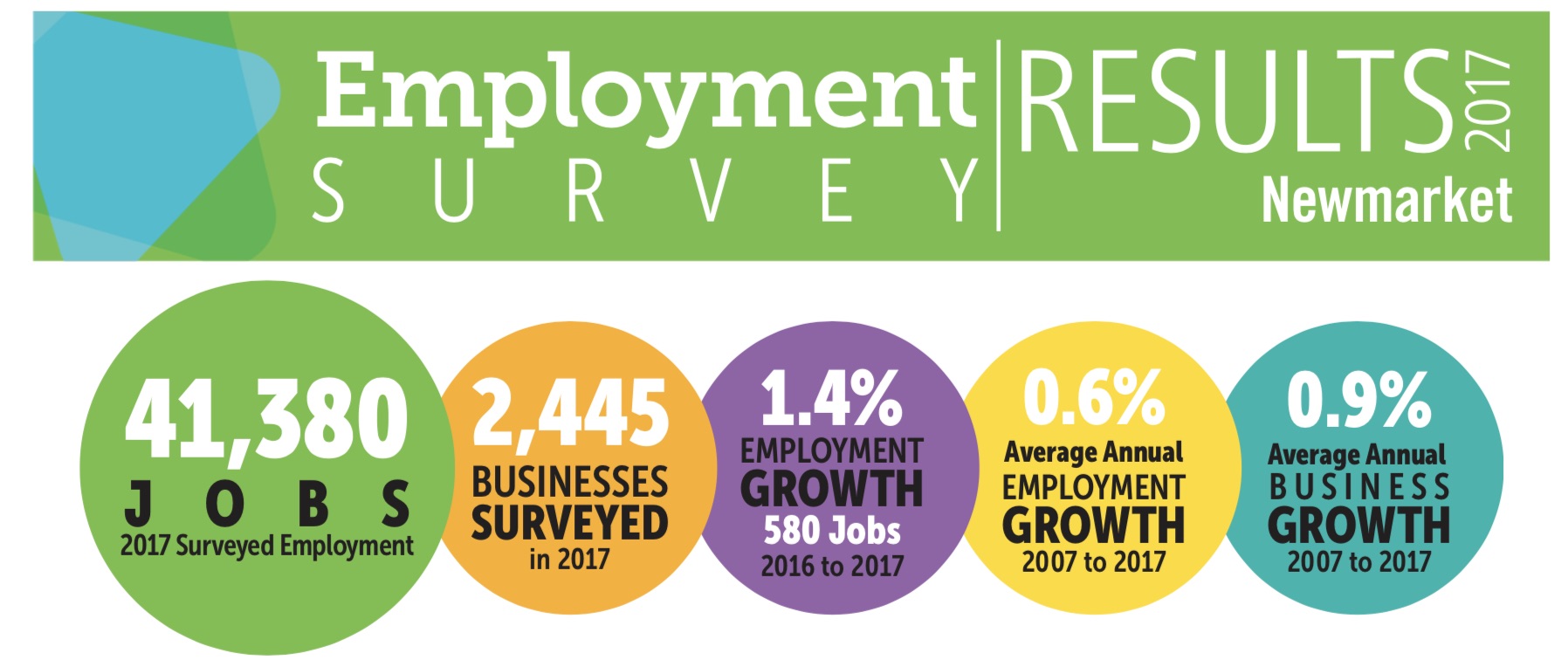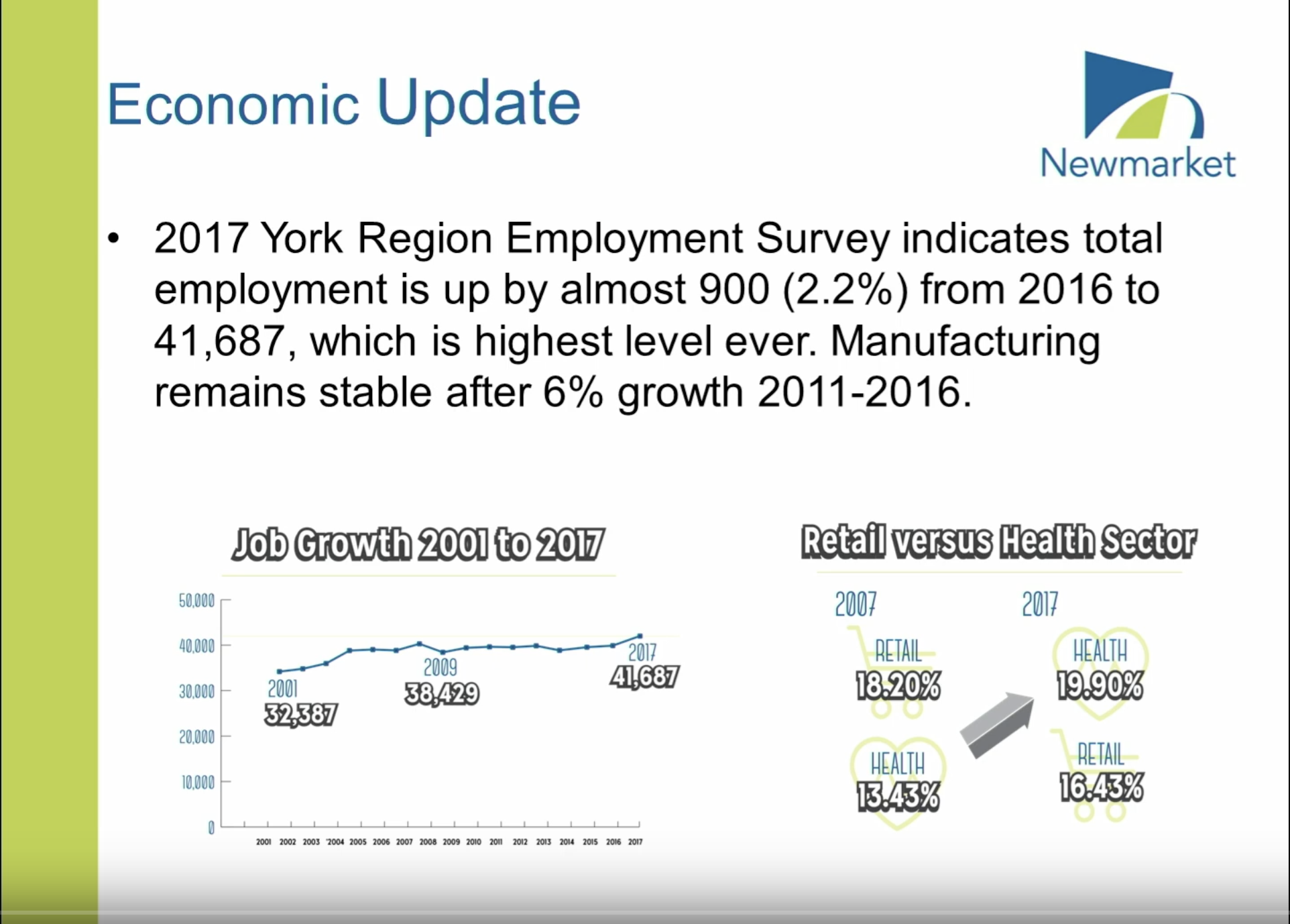580 new jobs were created in Newmarket from 2016 to 2017 – an employment growth rate of 1.4%.
Our neighbour to the South, Aurora, saw 1,070 new jobs created over the same period – a growth rate of 4.5%. 
Aurora consistently beats Newmarket in job creation. Since 1998 Newmarket has seen 9,600 new jobs. Aurora, 13,950.
Over the last decade Newmarket has seen an average annual business growth of 0.9%. The comparable figure for Aurora, 2.8%.
Why does Aurora grow more jobs?
Why is this? Does Aurora have more employment land? Or is it because it is closer to Toronto? Or are housing options more varied? What exactly are the factors?
You can see all the figures here in the 2017 Employment Survey Results for the nine municipalities of York Region.
There was a terrible kerfuffle three years ago when the Region published figures which suggested Newmarket had seen a paltry 100 jobs created over the period 2009-2014. At the time, I was sitting in on a York Region meeting and observed the look of incredulity on the faces of John Taylor and Tony Van Trappist.
Indeed, Van Trappist was actually moved to say something - as was Taylor. (The 100 figure was subsequently revised upwards.) Since then the Employment Surveys for individual municipalities are no longer front and centre. At York Region they’ve taken a back seat to region-wide figures and analysis. That way less likely to cause embarrassment.
As it happens, the Town’s Economic Development Officer, Chris Kallio, gave a presentation to the Committee of the Whole on 26 February 2018 entitled: 2017 Economic Development: the Year in Review.
Upbeat and breathless
It is all very upbeat and breathless with lots of pace, flagging up big new employers such as Celestica (a high tech company) and Gin-Cor (who make specialist vehicles) that are moving into Town. You can see the presentation which comes at the start of the meeting here on You Tube. 
But instead of the 580 new jobs I was expecting I see 900 and instead of employment growth of 1.4% I see 2.2%
The slide alongside credits the information as coming from the 2017 York Region Employment Survey. Perhaps the Town uses the calendar year whereas the Region uses the survey period from mid-year 2016 to mid-year 2017. Perhaps the answer lies in the definition of "total employment". In any event it is important we compare apples with apples, especially in an election year.
Big new employers not in the latest figures
John Taylor, who sits on the Regional Council, asks if the 2017 figures include the numbers from Celestica and Gin-Cor and is told no.
He points to jobs on the way at Upper Canada Mall, the Oskar Building on Davis Drive and the old Price Chopper on Leslie Street which is morphing into a new medical centre. He is upbeat.
You can read York Region’s 2017 Economic Development Review here and the Region’s February report here which focusses more on job growth.
York Region is on steroids, growing fast:
Employment growth in York Region has outpaced national, provincial and Greater Toronto Area (GTA) employed labour force growth between mid-year 2016 and mid-year 2017, posting a gain of 3.3%, a slightly lower growth rate than 2016 (3.6%).
Over the past five years York Region has grown at an average annual rate of 3.2%, outperforming growth rates in the national (2.1%), provincial (1.8%) and GTA (1.4%) economies.
According to York Region’s employment survey, employment rose to an estimated 620,530 jobs in 2017, an increase of 3.3% or 19,780 jobs from 2016.
But, worryingly, the big growth in contract work continues.
Between 2007 and 2017 the number of contract/seasonal/temporary employees has been steadily increasing. In 2007 the share of this employment category was 4.5%, while in 2017 it was 13.4%. As the share of contract/seasonal/temporary employment increases, full-time employment has decreased from 76% in 2007 to 69% in 2017. Although full time employment remains strong, the steady increase of contract/seasonal/temporary employment is indicative of the shifting job market since the 2008-2009 economic downturn and the rise of contract work that followed.
Precarious employment is a big and growing issue.
Time for us to wake up and take notice.
This email address is being protected from spambots. You need JavaScript enabled to view it.
